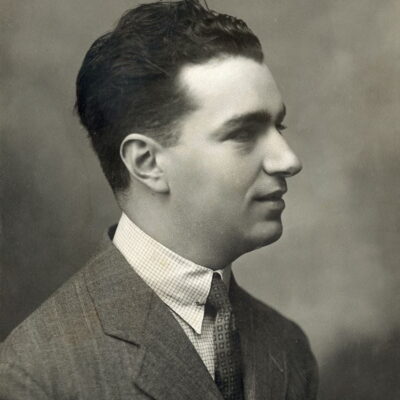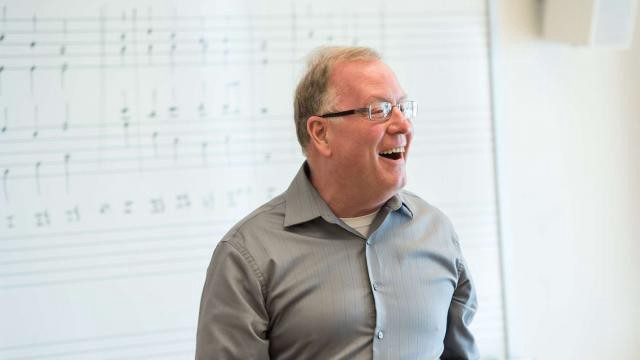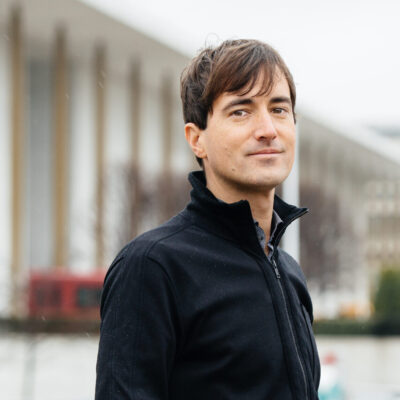
Richard Strauss (1864–1949)
Serenade in E-flat Major, Op. 7 (1881)
Richard Strauss may have been a mere puppy when he wrote his Serenade for wind ensemble, but he was a frisky puppy indeed, already the author of a handful of compositions including a string quartet, a piano sonata, and even an unpublished symphony. He was raised in an intensely musical home, thanks to his father’s position as principal horn of the Munich Court Orchestra. Papa Strauss held deeply conservative musical beliefs. He worshipped Mozart, Haydn, and Beethoven as archangels and condemned Richard Wagner as hellspawn. It was inevitable that at least some of that ingrained classicism would percolate down to his spectacularly gifted son.
Thus when the 17-year-old Richard wrote his Serenade for wind instruments in 1881, he instinctively channeled the spirits of Mozart, Mendelssohn, and Weber into a single-movement work that eschews Wagnerian excess while offering modern listeners the occasional (very faint) hint of the Richard Strauss to come. Which isn’t to say that it sounds anythinglike Der Rosenkavalier, Don Juan, or Also sprach Zarathustra, because it doesn’t. That Richard Strauss hadn’t been invented yet. Taken simply on its own as a worthy addition to the woodwind repertory, the Strauss Serenade is a delightful concoction of expert craftsmanship, superb instrumental writing, and that irresistibly endearing demeanor that is the special provenance of the very young.
Lou Harrison (1917–2003)
Concerto for Violin with Five Percussionists (1959–1940)
No, that’s not a misprint. It really is dated 1959–1940.
Years ago I attended a symposium with Lou Harrison in which he described Beethoven as a “northwest Asian composer.” Eyebrows went up all around the room. Harrison explained himself by suggesting that we consult a map. Consider Asia—a giant landmass covering a sizeable portion of the globe, then consider Europe—a peninsula sticking out from the northwest edge of that giant landmass. Thus Beethoven as a northwest Asian composer, right along with Bach and Mozart and Haydn and, well, every European. To be sure, Harrison’s impish sense of humor was making itself felt. Nevertheless, he had a point.
That point being that Westerners tend to suffer from cultural myopia and rarely see beyond their own self-determined borders. That short-sightedness extends to composers, among whom only a few have ventured beyond the confines of the Western musical tradition. In ‘Madame Butterfly’ Giacomo Puccini dabbled in Japonisme, followed by Chinoiserie in ‘Turandot’; Claude Debussy evoked an Indonesian gamelan (percussion ensemble) in ‘Pagodes’; Benjamin Britten went so far as to incorporate a quasi-gamelan in both ‘Prince of the Pagodas’ and, most memorably, ‘Death in Venice’. Lou Harrison outdid them all by expanding his gaze to include the techniques, idioms, and even tuning systems of Asian music. He was an American composer in that he was born in Portland, Oregon and spent his happiest adult years in Aptos, California near Santa Cruz. But when all is said and done, Lou Harrison was a citizen of the world.
Harrison completed his Concerto for Violin with Five Percussionists in 1959, after a long period of transformation that began around 1940 as he extricated himself from aggressive modernist idioms such as serialism while recovering from devastating bouts of depression. (Thus his dating of the piece as looking back from 1959 to 1940.) Harrison’s fascination with Indonesian music began with that recovery and continued nonstop for the rest of his career.
The Violin Concerto is not written for an actual gamelan per se, but its array of percussion instruments—including flowerpots, plumbers’ pipes, temple blocks, and spring coils along with standard orchestral percussion—elicits a distinctly Asian association. Even if the concerto can be brightly rhythmic at times, overall its textures are transparent and its moods delicate, the violin’s lyrical nature standing in sharp relief to the orchestra’s pointillistic sonic tapestry.
Wolfgang Amadeus Mozart (1756–1791)
Serenade No. 10 in B-flat Major, K. 361(370a) “Gran partita”
It is said that sometimes sweet water can be drawn from a foul well. Case in point: Mozart’s glorious late works written for his good buddy Anton Stadler, a pioneering clarinet virtuoso with a nasty case of arrested development and a singular lack of everyday morals. Mozart clearly valued Stadler beyond mere appreciation of his superb playing. He was quite fond of him personally, even if nobody else could stand the guy. Notschibinitschibi, Mozart nicknamed him—a whimsical concoction of slang words for ‘doofus’ and ‘pauper,’ something along the lines of ‘Dumbitybumbity.’ Stadler repaid Mozart by stealing from him, and after Mozart’s death, he either lost or pawned the autograph manuscript of the Clarinet Concerto. Some friend, that Dumbitybumbity.
To the roster of sublime masterpieces that Mozart wrote with Stadler’s playing in mind—it includes the Clarinet Quintet K. 581, Clarinet Concerto K. 622, the Clarinet Trio K. 498 and the Masonic Funeral Music K. 477—we can add Serenade No. 10 in B-flat Major, K. 361(370a). Somebody—we don’t know who—christened it as the “Gran partita” in the autograph score. It has been known as such ever since.
In choosing to write a Serenade for Stadler rather than, say, a concerto, Mozart was reflecting his origins in Salzburg, where orchestral hodgepodges, a.k.a. serenades, made up of dances, marches, and symphonic movements, were all the rage. For this, the last of his three wind serenades written in Vienna, Mozart happily experimented with orchestral color, making particular use of both the clarinet and the basset horn, Stadler’s instruments of choice. Four pairs of winds—oboes, B-flat clarinets, basset-horns in F, and bassoons—are joined by four horns (in F and B-flat) and an underlying string bass. Amidst the Serenade’s mixed bag of seven movements we find variations, two minuets, a “Romanze,” and perhaps most memorably, a third movement Adagio of breathtaking lyricism.
Program Annotator Scott Foglesong is the Chair of Musicianship and Music Theory at the San Francisco Conservatory of Music, and a Contributing Writer and Lecturer for the San Francisco Symphony. He also leads the California Symphony’s ground-breaking music education course for adults Fresh Look: The Symphony Exposed.
The 23-24 TRAILBLAZERS Season continues with MOZART SERENADES, on Saturday, March 16 at 7:30 p.m. and Sunday, March 17 at 4 p.m. at the Lesher Center for the Arts in Walnut Creek. Tickets are $45 to $90 and $20 for students 25 and under, and include a free 30-minute pre-concert talk starting one hour before the performance. Buy tickets online or call or visit the Lesher Center Ticket Office at 925.943.7469, Wed – Sun, 12:00 noon to 6:00 p.m.



